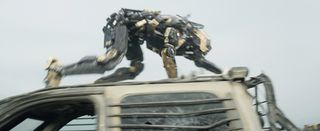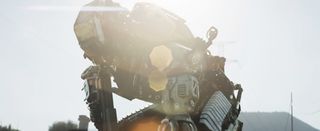How to animate a CG droid
Senior animator at Image Engine Earl Fast explains the process behind animating the CG droids in Neill Blomkamp's hit movie Elysium.

The rotomation process begins with the matchmove department. After the filmed plates are imported into our pipeline a matchmove artist tracks all the important assets in the scene. This includes creating a 3D camera that mimics the real camera's motion and settings any relevant and necessary set pieces (floors and walls for example) and all their positions relative to a fixed point in space. This would also include one or two rough key poses of the greysuit actors.
The result is a reproduction of the practical shot in the computer that is then passed on to the animation department. Once animation received the approved matchmove scene, the animator would quickly do an assessment of the elements received - confirming that the elements in the shot are in proper world space and ready for animation blocking. At this stage the animator would begin to block motion the greysuit actor, making sure to match every head turn, weight shift, and foot fall.
As the animation progresses beyond blocking we held a series of reviews with the lead animator and the VFX supervisor to make sure that every detail of the actor motion was captured correctly and accurately. It was through this process that a level of interpretation had to be worked into each performance.

The CG droids are rigid body machines that have limitations to some of their movements. Rotation points, flexibility, and body mass distribution are all factors that the animation team had to take into account when animating the droid asset and they did not always match the attributes on the human actors. Many pose adjustments had to be made to visually match the actors performance as well as trying to cover as much of the actor as possible in an effort to reduce the amount of paint-out required.
The last animation pass on these types of shots was a very fine technical walk-through to make sure that all the cables, hoses, antenna, and the fans were functioning properly. This was really a final quality control pass, as most of these elements were already moving as part of the droid rig. We occasionally had to fix their positions if the pose or action resulted in them crashing through each other breaking all together.

At this point, our lighting and rendering departments would pick up the shot and begin to render the droids. This would sometimes catch a few fine details that would need to be fixed and animation would then make those quick fixes and pass them back to the lighter.
Many of the shots we animated had actors and CG droids interacting with each other. In this kind of shot shadows, reflections, and contact points were very important. Animating a digital double for the real character was a highly-accurate way of getting this type of information that our compositing team could use to complete the illusion of the droid actually being in the shot.
This article originally appeared in 3D World issue 174.
Liked this? Read these!
- Create a perfect mood board with these pro tips
- The best 3D movies of 2013
- Download free textures: high resolution and ready to use now

Thank you for reading 5 articles this month* Join now for unlimited access
Enjoy your first month for just £1 / $1 / €1
*Read 5 free articles per month without a subscription

Join now for unlimited access
Try first month for just £1 / $1 / €1
Get the Creative Bloq Newsletter
Daily design news, reviews, how-tos and more, as picked by the editors.
The Creative Bloq team is made up of a group of design fans, and has changed and evolved since Creative Bloq began back in 2012. The current website team consists of eight full-time members of staff: Editor Georgia Coggan, Deputy Editor Rosie Hilder, Ecommerce Editor Beren Neale, Senior News Editor Daniel Piper, Editor, Digital Art and 3D Ian Dean, Tech Reviews Editor Erlingur Einarsson and Ecommerce Writer Beth Nicholls and Staff Writer Natalie Fear, as well as a roster of freelancers from around the world. The 3D World and ImagineFX magazine teams also pitch in, ensuring that content from 3D World and ImagineFX is represented on Creative Bloq.
